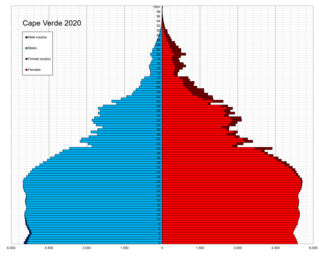
Demographic features of the population of Cape Verde include population density, ethnicity, education level, health of the populace, economic status, religious affiliations and other aspects of the population.

Boa Vista, also written as Boavista, is a desert-like island that belongs to the Cape Verde Islands. At 631.1 km2 (243.7 sq mi), it is the third largest island of the Cape Verde archipelago.

Italian Canadians are Canadian-born citizens who are fully or partially of Italian descent, whose ancestors were Italians who migrated to Canada as part of Italian diaspora, or Italian-born people in Canada. According to the 2021 Census of Canada, 1,546,390 Canadians claimed full or partial Italian ancestry. They comprise a subgroup of Southern European Canadians which is a further subgroup of European Canadians. The census enumerates the entire Canadian population, which consists of Canadian citizens, landed immigrants and non-permanent residents and their families living with them in Canada. Residing mainly in central urban industrial metropolitan areas, Italian Canadians are the seventh largest self-identified ethnic group in Canada behind French, English, Irish, Scottish, German and Chinese Canadians.
Cape Verdean Americans are an ethnic group of Americans whose ancestors were Cape Verdean. In 2010, the American Community Survey stated that there were 95,003 Americans living in the US with Cape Verdean ancestors.
Portuguese Luxembourgers, also known as Luso-Luxembourgers, are the citizens or residents of Luxembourg whose ethnic origins lie in Portugal, including both Portuguese-born citizens with Luxembourg citizenship and Luxembourg-born citizens of Portuguese ancestry or citizenship.

Cape Verdean Argentines are Argentine residents whose ancestry originated in Cape Verde. According to the 1980 census, there were about 8,000; but today's population was estimated by some sources to be around 2,000 in 2007. Other sources estimate that in 2006 there were 12,000-15,000 descendants of immigrants from Cape Verde living in Argentina, of whom about 300 are native to the African continent.
Cape Verdeans in France are residents of France who are from Cape Verde or have Cape Verdean ancestry.
In 1995, it was estimated that there were 50,000 people of Cape Verdean descent or national origin in Portugal. By 2000, this estimation rose to 83,000 people, of which 90% resided in Greater Lisbon." In 2008, Portugal’s National Statistics Institute estimated that there were 68,145 Cape Verdeans who legally resided in Portugal. This made up "15.7% of all foreign nationals living legally in the country."
Cape Verdeans in the Netherlands consist of migrants from Cape Verde to the Netherlands and their descendants. As of 2022, figures from Statistics Netherlands showed 23,150 people of Cape Verdean origin in the Netherlands.
There were estimated to be 25,000 Cape Verdeans in Senegal as of 1995.
The presence of Cape Verdeans in Italy dates back to the 1960s.
Cape Verdean Spaniards are residents of Spain whose ancestry originated in Cape Verde.
The Cabo Verdean diaspora refers to both historical and present emigration from Cape Verde. Today, more Cabo Verdeans live abroad than in Cape Verde itself. The country with the largest number of Cape Verdeans living abroad is the United States.

Cape Verde or Cabo Verde, officially the Republic of Cabo Verde, is an archipelago and island country of West Africa in the central Atlantic Ocean, consisting of ten volcanic islands with a combined land area of about 4,033 square kilometres (1,557 sq mi). These islands lie between 600 and 850 kilometres west of Cap-Vert, the westernmost point of continental Africa. The Cape Verde islands form part of the Macaronesia ecoregion, along with the Azores, the Canary Islands, Madeira, and the Savage Isles.
Angolan Americans are an ethnic group of Americans of Angolan descent or Angolan immigrants. According to estimates, by the year 2000 there were 1,642 people descended from Angolan immigrants in the United States. However, the number of Angolan Americans is difficult to determine. Many African-Americans are descendants of Angolan enslaved people. In 1644, most of the 6,900 slaves bought on the African coast to clear the forests, lay roads, build houses and public buildings, and grow food came from the established stations in Angola.
African immigrants to Switzerland include Swiss residents, both Swiss citizens and foreign nationals, who have migrated to Switzerland from Africa. The number has quintupled over the period of 1980 to 2007, with an average growth rate of 6% per annum. According to official Swiss population statistics, 73,553 foreigners with African nationality lived in Switzerland as of 2009. Since the census records nationality, not ethnic origin, there is no official estimate of the number of naturalized Swiss citizens from Africa.
The Africans in Hawaii, also known as Pōpolo in the Native Hawaiian language, are a minority of 4.0% of the population including those partially Black, and 2.3% are of African American, Afro-Caribbean, or African descent alone. The Black population is mostly concentrated in the Greater Honolulu area, especially near military installations. There is also a sizeable Cape Verdean American population, and there are some Hispanic people of African descent, namely Puerto Ricans.
The city of Newark, New Jersey, includes a large Portuguese-speaking population. Newark has been nicknamed "Little Portugal" due to its large number of Portuguese-speaking and Portuguese-descended people. Most Lusophone Americans in Newark live in the working-class neighborhood of Ironbound.

Cape Verdeans, also called Cabo Verdeans, are a creole ethnic group native to Cape Verde, an island nation in West Africa consisting of an archipelago in the central Atlantic Ocean. Cape Verde is a nearly homogeneous creole society, which means that it is home to people of many different racial origins who share a common culture and heritage. Cabo Verdeans may consider themselves to be different races, though most do not, seeing themselves as Verdean, but also share a national identity and are welcoming to African and European immigrants to their islands.

Val Xalino is a Capeverdean singer and producer who currently resides in Gothenburg, Sweden. He is the father of the Cape Verdean singer and producer Robert Xalino.





